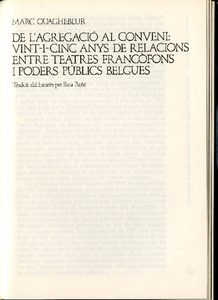De l'agregació al conveni: vint-i-cinc anys de relacions entre teatres francòfons i poders públics belgues

Visualitza/
Metadades
Mostra el registre d'unitat complet
Estudis escènics: quaderns de l'Institut del Teatre. 1985, Núm. 26
Tipus de documentArticle
Abstract
<p>The idea of regularly subsidising companies of dramatic art goes back to the years following the Liberation. The arrangement that was applied until recently, however, originated from two decrees of 9th October, 1957. As far as French speaking Belgium is concerned this fact is important in that it allowed the national theatre to face up to competition from the French companies who carne on tour. Official protection reverted in the most part to the National Theatre, while the remaining companies had to approximately share out half of the subsidy budget, using a complicated system of arbitration. A minimum of 200 performances a year was expected as a condition of receiving the subsidy; this measure applied both to the companies that performed in the in the Walloon provinces, as well as the more innovative theatre of the Esprit Frappeur, founded in 1963, and the Vicinal or the Parvis, founded in 1970. As from the 1970s the measures of protection begin to become more moderate, benefitting a greater agility. The theatrical life of Brussels is one of the richest and most varied in Europe, and one can find entertainment specially for children as well as avant-garde genres. Present day authors and theatrical designers continue a Brussels tradition that includes Maeterlinck and Crommelynck among its most illustrious names.</p>
Condicions d'accésAccés obert
ISSN2385-362X
,
0212-3819
Col·leccions
- 1985: Núm.: 26 [5]

